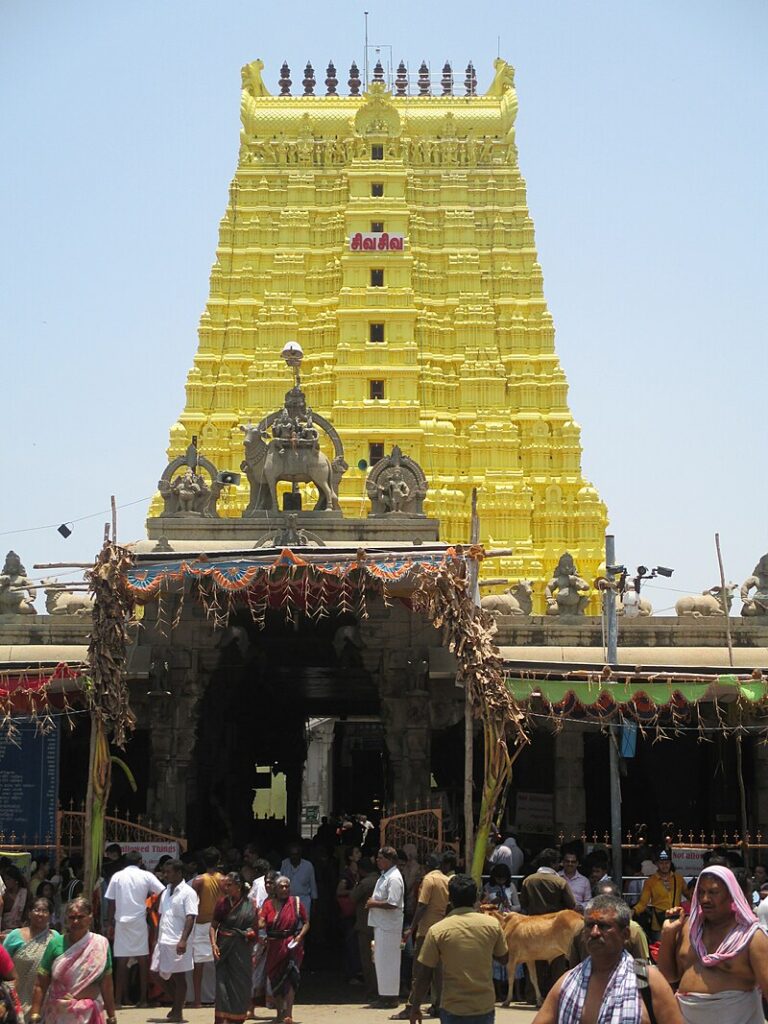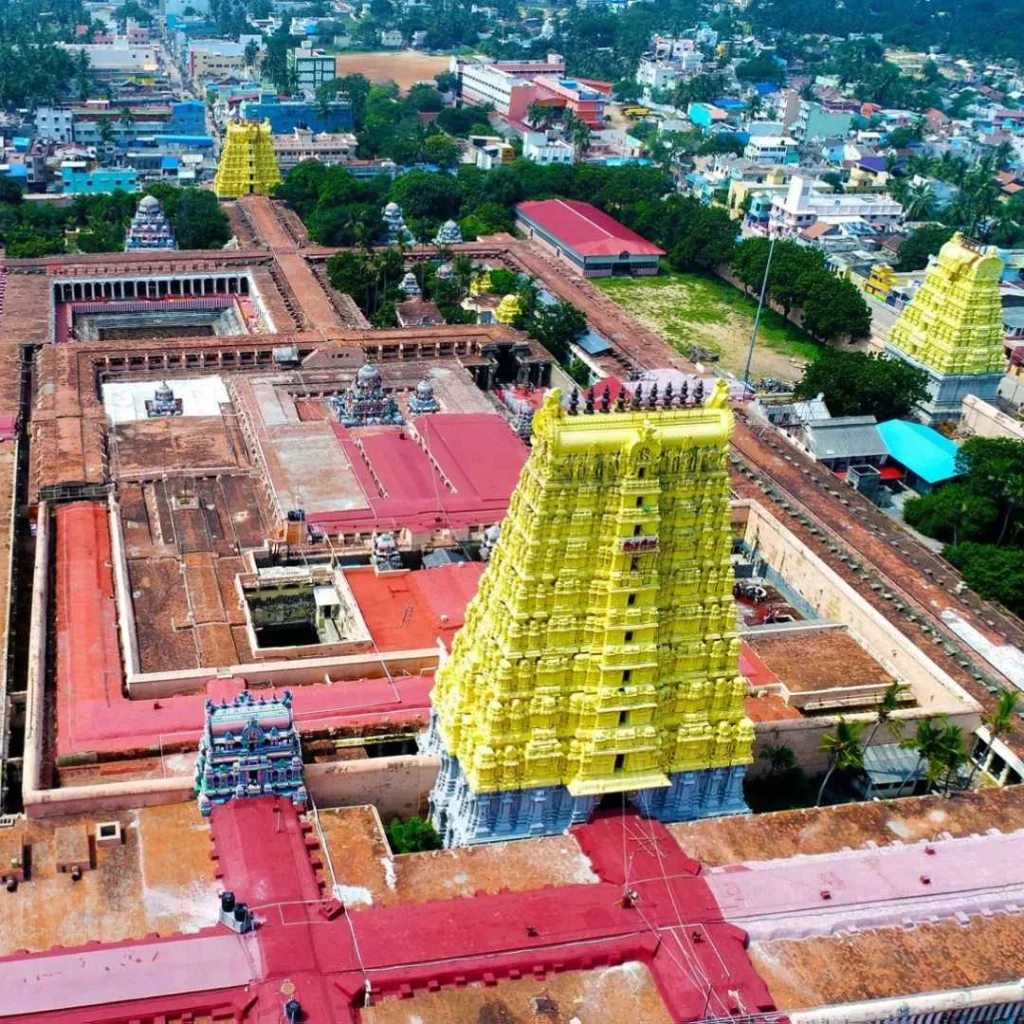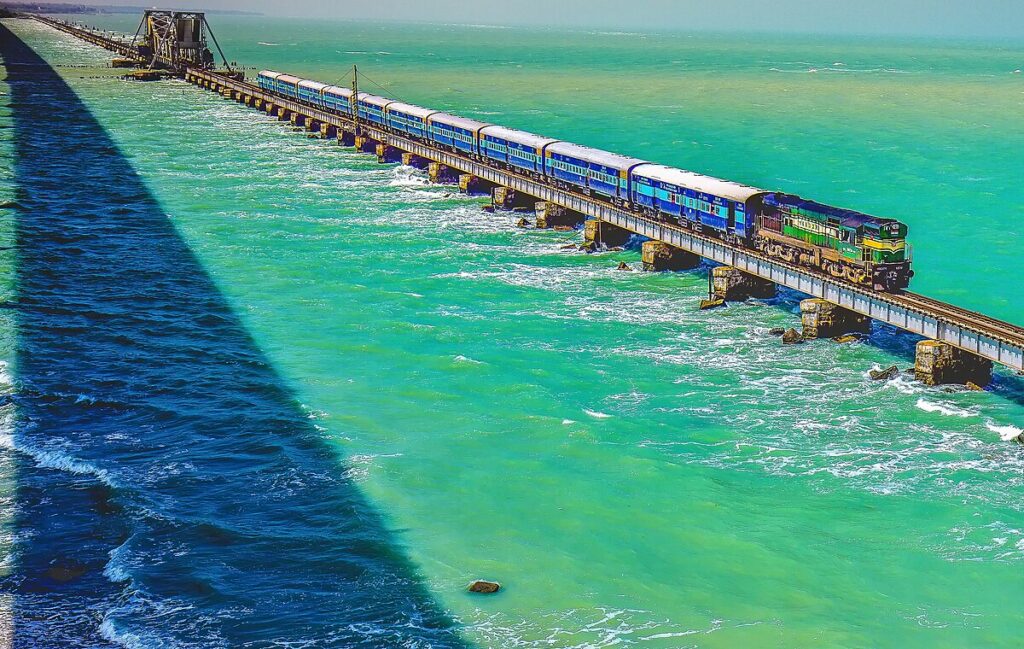Introduction
Ramanathaswamy Temple is dedicated to Lord Shiva and is one of India’s most famous Hindu temples in India. It is also one of the 12 Jyotirlingas and one of the Char Dham sites. The temple is located in the city of Rameshwaram, on an island in the Tamil Nadu state of South India. It is a marvel of man-made architecture that attracts many tourists, The importance of Ramanathaswamy in the south is said to be comparable to that of Kashi in the north.

Ramanathaswamy Temple
Table of Contents
Discover the Spiritual Splendor of Ramanathaswamy Temple, Rameswaram
Ramanathaswamy Temple, located in the serene town of Rameswaram, Tamil Nadu, stands as a timeless symbol of devotion, spirituality, and architectural brilliance. As one of the twelve sacred Jyotirlingas of Lord Shiva, this temple draws millions of pilgrims and tourists from across the globe, offering them a unique blend of mythology, history, and divine grace.
A Glimpse into the History and Mythology
The origins of Ramanathaswamy Temple are deeply intertwined with the epic Ramayana, one of Hinduism’s most revered texts. According to legend, Lord Rama, after vanquishing the demon king Ravana, sought to atone for the sin of killing a Brahmin. Although Ravana embodied evil, his lineage as a Brahmin necessitated a ritual to absolve Rama of his actions.
To perform this penance, Lord Rama decided to worship Lord Shiva. He entrusted Lord Hanuman with the task of bringing a sacred Shivling from Mount Kailash. However, Hanuman’s journey was delayed, and to ensure the ritual proceeded without hindrance, Sita, Rama’s consort, crafted a Shivling out of sand. This Shivling, known as the “Ramalingam,” became the focal point of the worship. When Hanuman finally arrived with the Shivling, known as the “Vishwalingam,” it was also consecrated and placed alongside the sand Shivling.
This dual presence of Shivlings within the temple is symbolic of devotion, unity, and reverence. The name “Ramanathaswamy,” translating to “Lord of Rama,” further emphasizes the temple’s profound connection to the Ramayana.
Architectural Marvel
The Ramanathaswamy Temple is a masterpiece of Dravidian architecture. Its intricately carved pillars, towering gopurams (entrance towers), and expansive corridors leave visitors awestruck. The temple boasts the longest corridor among all Hindu temples in the world, stretching over 1,200 meters and adorned with over 1,200 intricately sculpted granite pillars. Each pillar is a testament to the artistic brilliance of ancient Indian craftsmen.
The temple’s sanctum houses the two Shivlings, the Ramalingam and Vishwalingam, which are worshipped with equal reverence. The temple complex also features several sacred water tanks or “teerthams.” Devotees believe that bathing in these teerthams cleanses them of sins and purifies the soul.
Spiritual Significance
As one of the twelve Jyotirlingas, Ramanathaswamy Temple holds immense spiritual importance for Hindus. Pilgrims undertake a journey to this sacred shrine to seek blessings, fulfill vows, and attain spiritual solace. The temple is also a part of the Char Dham Yatra, one of the holiest pilgrimages in Hinduism, which includes Badrinath, Dwarka, and Puri.
The rituals and daily prayers conducted within the temple follow age-old traditions, creating an atmosphere of divinity and tranquility. Devotees often recount feeling a deep sense of peace and connection to the divine during their visit.
How to Reach Ramanathaswamy Temple
Rameswaram is well-connected by various modes of transport, making it accessible to pilgrims and tourists from different parts of India and beyond.
By Train
Rameswaram Railway Station is the nearest railway hub, located just 0.75 kilometers from the temple. Regular trains connect Rameswaram to major cities in Tamil Nadu, including Chennai, Madurai, and Coimbatore, as well as other parts of India. The scenic train ride across the Pamban Bridge, which connects the island of Rameswaram to mainland India, is a highlight of the journey.
By Flight
For air travelers, the nearest airport is Madurai International Airport, situated approximately 174 kilometers from Rameswaram. From Madurai, visitors can hire a taxi or board a train to reach Rameswaram. The road journey from Madurai to Rameswaram is particularly picturesque, offering views of lush landscapes and coastal beauty.
By Bus
Regular bus services operate between Rameswaram and nearby cities like Madurai, Tiruchirappalli, and Chennai. The nearest bus stand to Ramanathaswamy Temple is about 2 kilometers away. From the bus stand, local transportation options such as auto-rickshaws and taxis ensure easy access to the temple premises.
Best Time to Visit
The ideal time to visit Ramanathaswamy Temple is between October and April, when the weather is pleasant and conducive for exploring the temple and its surroundings. Festivals like Maha Shivaratri and Ram Navami are celebrated with great fervor, making these periods especially significant for a visit.
Exploring Rameswaram
While Ramanathaswamy Temple is the crown jewel of Rameswaram, the town offers several other attractions for visitors. The nearby Dhanushkodi Beach, often referred to as the “Ghost Town,” showcases hauntingly beautiful ruins and stunning ocean views. The Pamban Bridge, an engineering marvel, is another must-see. Additionally, the Gandhamadhana Parvatham provides panoramic views of Rameswaram and is believed to have footprints of Lord Rama.
Conclusion
Ramanathaswamy Temple is not just a place of worship; it is a testament to India’s rich cultural and spiritual heritage. Its connection to the Ramayana, coupled with its architectural grandeur and spiritual ambiance, makes it a must-visit destination for anyone seeking divine blessings or an enriching cultural experience. Whether you’re a devotee, a history enthusiast, or a traveler in search of serenity, Ramanathaswamy Temple promises an unforgettable journey into the heart of India’s spiritual legacy.

